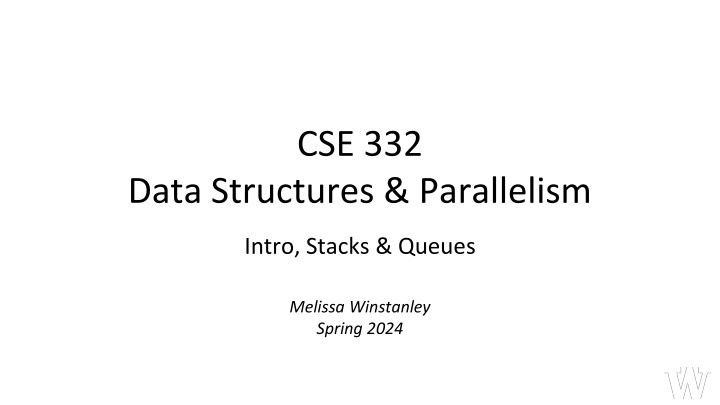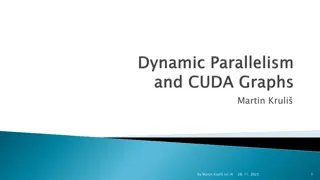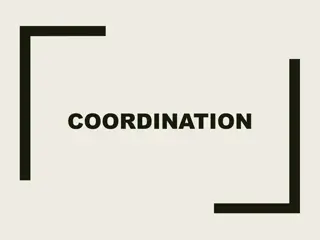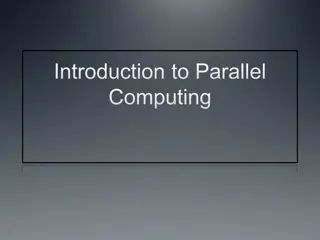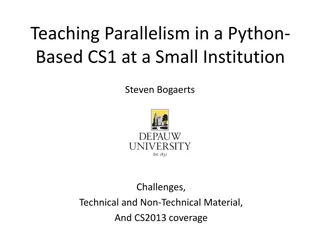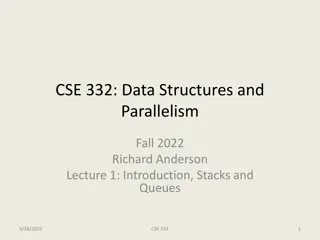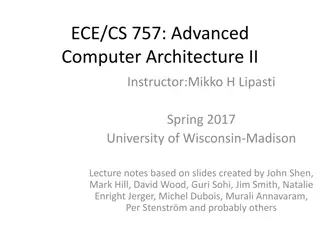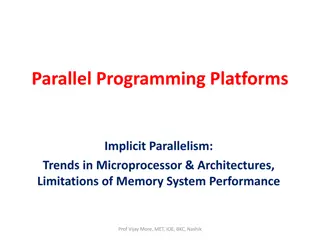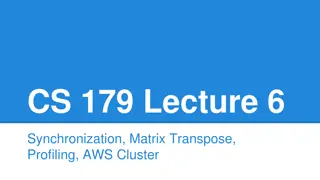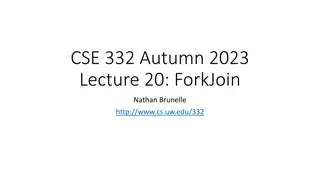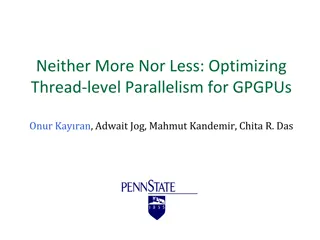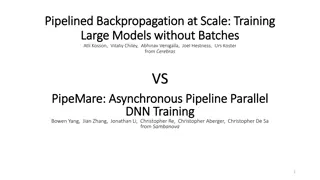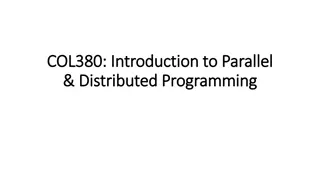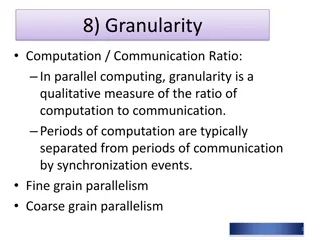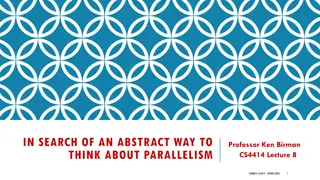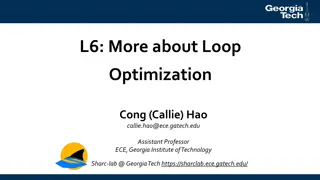CSE 332 - Intro to Data Structures & Parallelism
This course covers fundamental data structures, algorithms, and parallelism concepts. Topics include queues, dictionaries, graphs, sorting, and more. Meet the course staff and explore administrative details. Instructor Melissa Winstanley brings a wealth of experience in NLP, computing, and software engineering. Dive into data structure analysis, efficiency, and practical applications over a 10-week journey of learning and exploration.
Uploaded on Mar 19, 2025 | 2 Views
Download Presentation

Please find below an Image/Link to download the presentation.
The content on the website is provided AS IS for your information and personal use only. It may not be sold, licensed, or shared on other websites without obtaining consent from the author.If you encounter any issues during the download, it is possible that the publisher has removed the file from their server.
You are allowed to download the files provided on this website for personal or commercial use, subject to the condition that they are used lawfully. All files are the property of their respective owners.
The content on the website is provided AS IS for your information and personal use only. It may not be sold, licensed, or shared on other websites without obtaining consent from the author.
E N D
Presentation Transcript
CSE 332 Data Structures & Parallelism Intro, Stacks & Queues Melissa Winstanley Spring 2024
Welcome! We have 10 weeks to learn fundamental data structures and algorithms for organizing and processing information Classic data structures / algorithms and how to analyze rigorously their efficiency and when to use them Queues, dictionaries, graphs, sorting, etc. Parallelism and concurrency (!)
Today Introductions Administrative Info What is this course about? Review: Queues and stacks
CSE 332 Course Staff Instructor: Melissa Winstanley Teaching Assistants: Amanda Yuan Arya GJ Chandni Rajasekaran Hans Easton Hitesh Boinpally Mohamed Awadalla Nile Camai Xunmei Liu Yijia Zhao
Me (Melissa) Undergrad and 5th year masters at UW Research in NLP & computing in the developing world TA-ing (intro, networks) and teaching my own class Teaching Computer Science at UW CSE 143 (Intro II) / CSE 374 (Systems Programming) / DATA 515 (Software Design) Software Engineer at Meta, Convoy, & Snowflake Focus on large-scale backend infrastructure and platforms Extensive work with intern programs Passionate about making students into software engineers
Credit for the course Many thanks to: Ruth Anderson Winston Jodjana Nathan Brunelle
Today Introductions Administrative Info What is this course about? Review: Queues and stacks
Course Information Instructor: Melissa Winstanley, CSE 214 Office Hours: see course web page, and by appointment (mwinst@cs.washington.edu) Course Web page: http://www.cs.uw.edu/332 Text (optional): Data Structures & Algorithm Analysis in Java Mark Allen Weiss, 3rd edition, 2012 (2nd edition also o.k.)
Communication Course email list: cse332a_sp24@uw You are already subscribed You must get and read announcements sent there Ed STEM Discussion board Your first stop for questions about course content & assignments Anonymous feedback link For good and bad: if you don t tell us, we won t know!
Course Meetings Lecture Section Office hours Use them: please visit us Materials posted (sometimes afterwards), but take notes Ask questions, focus on key ideas (rarely coding details) No participation points - we re all adults here Practice problems! Answer Java/project/homework questions, etc. Occasionally may introduce new material An important part of the course (not optional) ESPECIALLY THIS WEEK!
Course Materials Lecture and section materials will be posted But they are visual aids, not always a complete description! If you have to miss, find out what you missed Textbook: Weiss 3rd Edition in Java Good read, but only responsible for lecture/section/hw topics Parallelism / concurrency units in separate free resources designed for 332
Course Work ~13 Weekly individual homework exercises (25%) 3 programming projects (with phases) (35%) Use Java and IntelliJ, Gitlab Done individually Midterm and final exam (40%) In-person, in this room (CSE2 G20) Dates: Midterm: Friday April 26, during lecture Final Exam: Thursday June 8, 8:30-10:20am
Collaboration policy Attempt the work on your own Then you can talk with classmates Whiteboard collaboration Do NOT take any photos/notes away from the session Wait 30 minutes before writing your own solution ONLY people from this iteration of the class Search the internet for general concepts only Cite any sources / collaboration When in doubt, cite!
Homework for today!!! 1. Preliminary Survey: due Thursday 2. Project #1: Checkpoint 0 due Friday 3. Review Java & install IntelliJ 4. Reading (optional) in Weiss (see course web page)
Today Introductions Administrative Info What is this course about? Review: Queues and stacks
Data Structures + Parallelism About 70% of the course is a classic data-structures course Timeless, essential stuff Core data structures and algorithms that underlie most software How to analyze algorithms Plus a serious first treatment of programming with multiple threads For parallelism: Use multiple processors to finish sooner For concurrency: Correct access to shared resources Will make many connections to the classic material
What 332 is about Deeply understand the basic structures used in all software Understand the data structures and their trade-offs Rigorously analyze the algorithms that use them (math!) Learn how to pick the right thing for the job Experience the purposes and headaches of multithreading Practice design, analysis, and implementation The elegant interplay of theory and engineering at the core of computer science
Goals You will understand: what the tools are for storing and processing common data types which tools are appropriate for which need So that you will be able to: make good design choices as a developer, project manager, or system customer justify and communicate your design decisions
One view of this course This is the class where you begin to think like a computer scientist You stop thinking in Java code You start thinking that this is a hashtable problem, a stack problem, etc.
Data Structures? Clever ways to organize information in order to enable efficient computation over that information.
Trade-Offs A data structure strives to provide many useful, efficient operations But there are unavoidable trade-offs: Time vs. space One operation more efficient if another less efficient Generality vs. simplicity vs. performance That is why there are many data structures and educated CSEers internalize their main trade-offs and techniques And recognize logarithmic < linear < quadratic < exponential
Getting Serious: Terminology List? Abstract Data Type (ADT) Mathematical description of a thing with set of operations on that thing Algorithm A high level, language-independent description of a step-by-step process Data structure A specific organization of data and family of algorithms for implementing an ADT Implementation of a data structure A specific implementation in a specific language
The Stack ADT Stack operations: push pop top/peek is_empty
Terminology Example: Stacks The Stack ADT supports operations: push: adds an item pop: raises an error if isEmpty, else returns most-recently pushed item not yet returned by a pop isEmpty: initially true, later true if there have been same number of pops as pushes (Often some more operations) A Stack data structure could use a linked-list or an array or something else, and associated algorithms for the operations One implementation is in the library java.util.Stack
Why useful The Stack ADT is a useful abstraction because: It arises all the time in programming (see Weiss for more) Recursive function calls Balancing symbols (parentheses) Evaluating postfix notation: 3 4 + 5 * Clever: Infix ((3+4) * 5) to postfix conversion (see Weiss) We can code up a reusable library We can communicate in high-level terms Use a stack and push numbers, popping for operators Rather than, create a linked list and add a node when
Today Introductions Administrative Info What is this course about? Review: Queues and stacks
The Queue ADT Queue operations: enqueue dequeue is_empty
Circular Array Queue Data Structure What if queue is empty? Enqueue? Dequeue? What if array is full? How to test for empty? What is the complexity of the operations?
Linked List Queue Data Structure What if queue is empty? Enqueue? Dequeue? Can list be full? How to test for empty? What is the complexity of the operations?
Circular Array vs Linked List Good about Good about the linked list? - no set size - don't have define size at the start - add elements in between easily circular arra y: - if we do wa nt to modify - less error prone - storing onl y one piece o f data
Circular Array vs Linked List Array: May waste unneeded space or run out of space Space per element excellent Operations very simple / fast List: Always just enough space But more space per element Operations very simple / fast Operations not in Queue ADT, but also: Constant-time access to kth element For operation insertAtPosition , must shift all later elements Operations not in Queue ADT, but also: No constant-time access to kth element For operation insertAtPosition must traverse all earlier elements
Homework for today!!! 1. Preliminary Survey: due Thursday 2. Project #1: Checkpoint 0 due Friday 3. Review Java & install IntelliJ 4. Reading (optional) in Weiss (see course web page)
